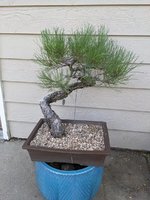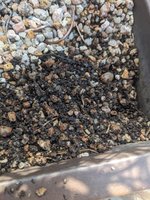JesseKane
Sapling
I recently purchased an established Ponderosa from a local practitioner that was down-sizing his collection. The tree is tagged to have been re-potted in 2004 (the previous owner deferred to the tag when asked), but I'm questioning if that was a marking mistake and it was instead re-potted this year. The soil is loose and well draining although it seems to be comprised of mostly fine pea gravel and organic matter. I dug down into the corner of the pot and did find some fine roots down deep but not nearly what I would expect from a tree in the same pot for 20 years. Could the organic matter be a sign that the soil has been completely broken down and is the result of old roots decaying, a sign the noted 2004 date is correct? The tree was collected in 1989 and was one of many of similar age in the collection.
The tree is currently pretty over-potted and ultimately I want to get it into a smaller pot to start working on needle reduction. Any other clues I should look for to determine when it's safe to re-pot? Pics below are the tree the day I purchased and the soil from today.


The tree is currently pretty over-potted and ultimately I want to get it into a smaller pot to start working on needle reduction. Any other clues I should look for to determine when it's safe to re-pot? Pics below are the tree the day I purchased and the soil from today.



